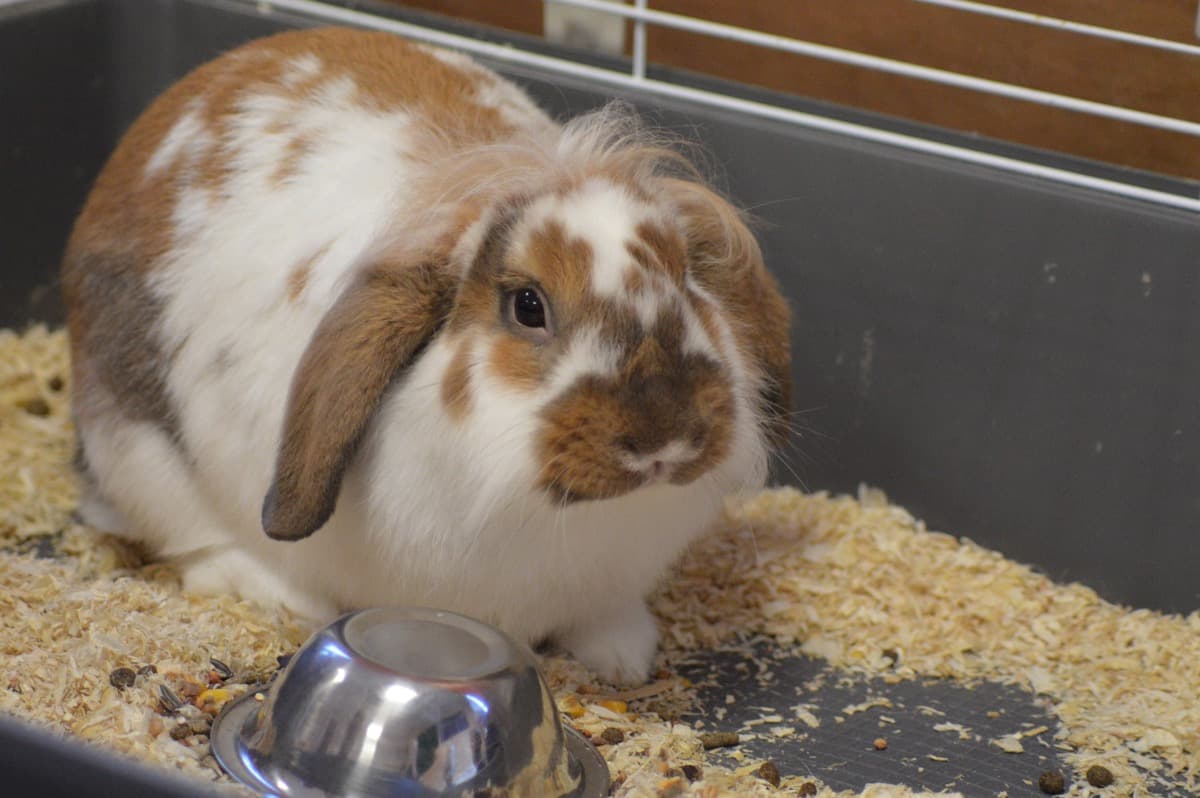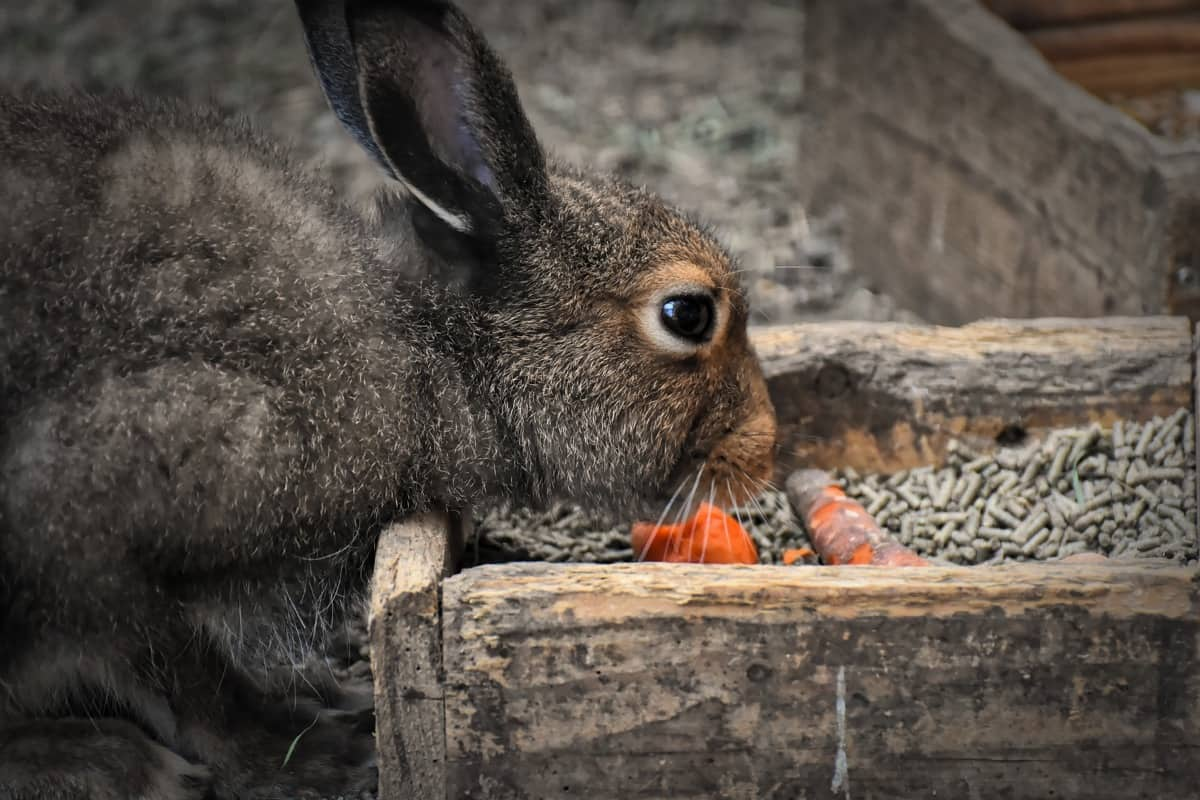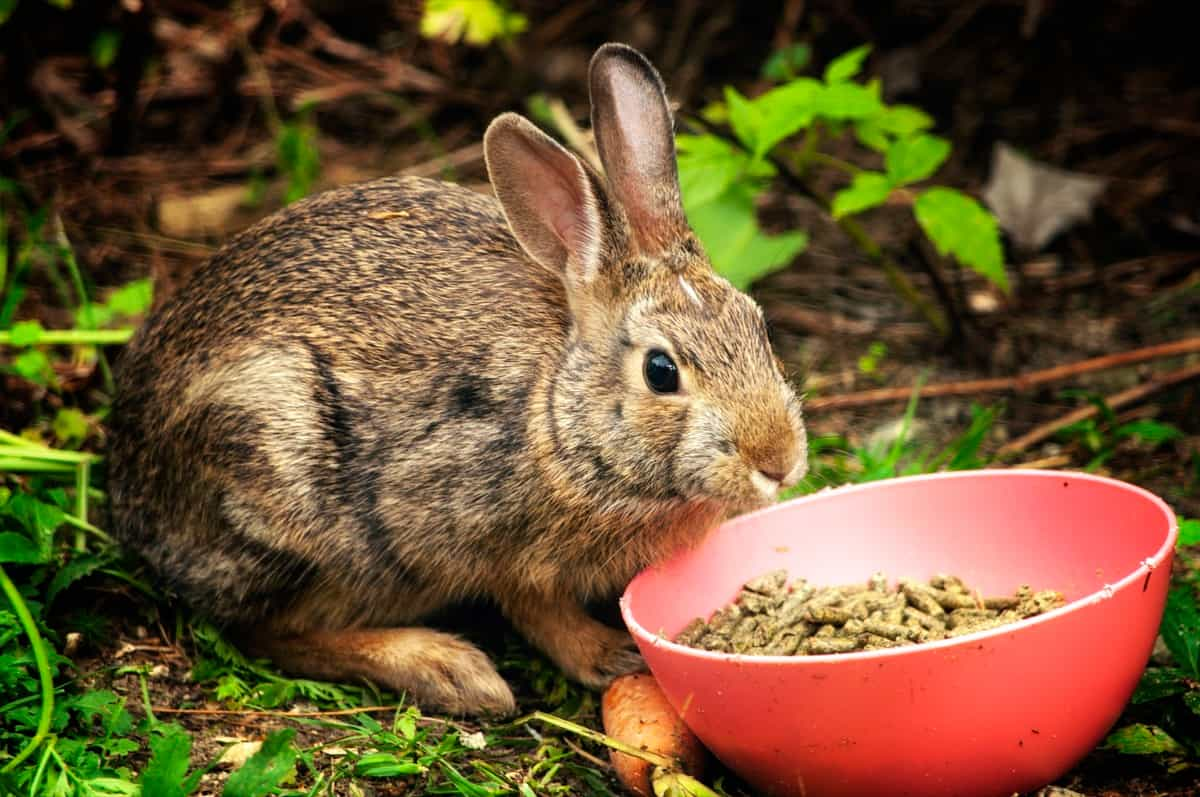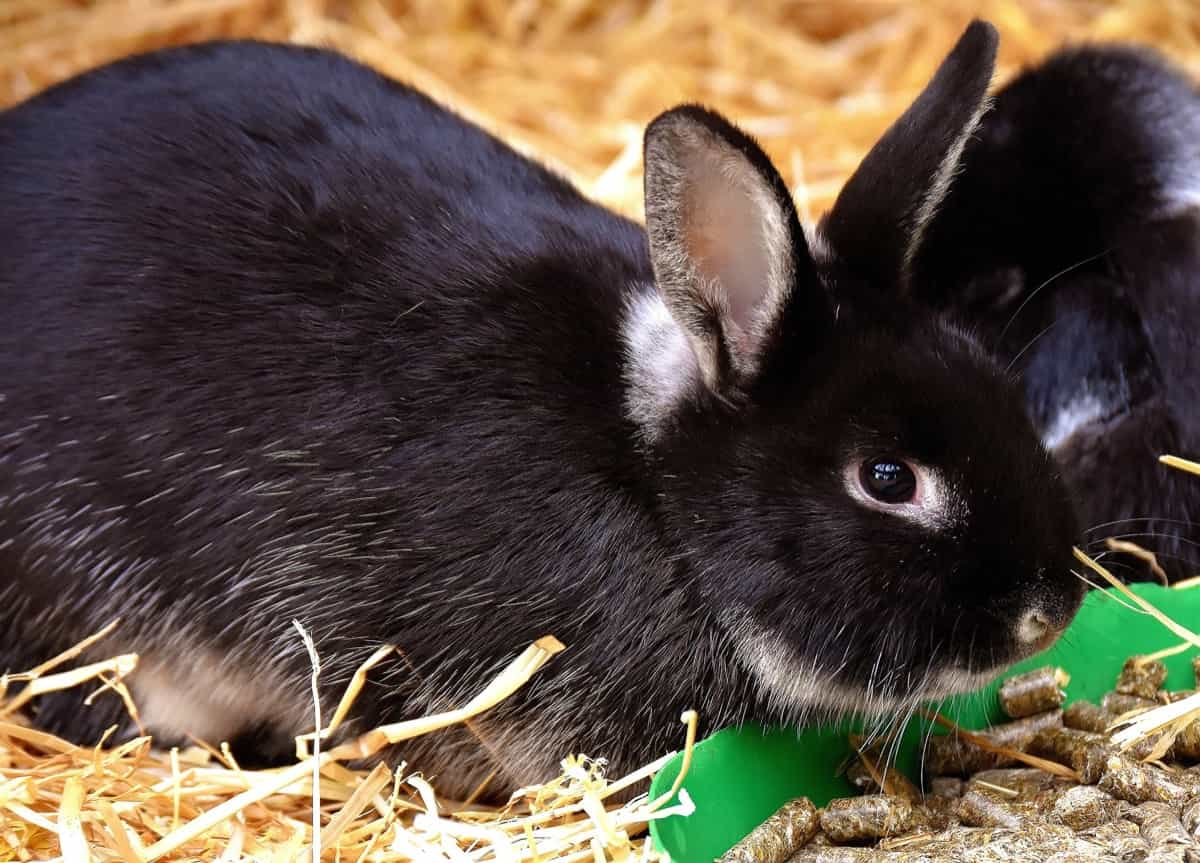A good Feed Conversion Ratio (FCR) is essential for any successful rabbit farmer. FCR measures the efficiency of feed usage in converting feed into body weight gain. A higher number means better efficiency and more profits for your business. With the right strategies, rabbit farming can become a profitable business for small-scale producers.

Key rules to improve Feed Conversion Ratio (FCR) in Rabbits
What is FCR in rabbit farming?
FCR is a vital statistic in commercial rabbit farming, directly impacting profitability. FCR measures the efficiency with which an animal converts feed into meat and is calculated by dividing the weight of the animal’s carcass by the weight of the feed consumed. A high FCR indicates efficient use of feed resources and is therefore desirable from an economic and ethical standpoint.
Different factors can impact FCR, including genetics, age, health status, housing, diet, and environment. Some factors are beyond the farmer’s control (such as genetics), but many things can be done to improve FCR. The most important rule for improving FCR is to provide rabbits with a high-quality diet that meets their nutritional needs.
This means using good-quality feeds and supplements and feeding them according to their specific requirements. Additionally, housing conditions play a role in FCR; rabbits need clean, comfortable quarters that allow them to move around freely. A stress-free environment is also important for optimal health and efficient feed conversion.
The importance of quality feed in rabbit farming
The FCR is an important element of animal performance and feed efficiency. It mainly measures how well an animal converts feed into body weight gain. As with any livestock farming, feeding is critical to success in rabbit production. The feed quality is just as important as the quantity, and producers should pay close attention to both when formulating a diet for their rabbits. Nutrients are important for rabbits, and the right mix of these will help to ensure good growth and development.
In case you missed it: Key Rules to Improve Feed Conversion Ratio (FCR) in Pigs: For Better Profits in Pig Farming

For example, protein is essential for muscle growth, while fiber is important for digestive health. Both must be in the diet in the correct proportions to achieve optimal results. In addition to meeting the nutritional needs of the rabbits, it is also important to consider the cost of the feed. A higher-quality feed will typically be more expensive, but it may be worth the investment if it results in better overall animal performance.
Which is the best feed conversion ratio FCR in rabbit farming?
The best feed conversion ratio (FCR) in rabbit farming depends on several factors, including the type of rabbit, the quality of the feed, and the management practices used.
- Type of Rabbit – Different types of rabbits have different FCRs. For example, New Zealand White rabbits have an FCR of about 2:1, while California rabbits have an FCR of about 3:1. The rabbit breed also affects the FCR. Some breeds are more efficient at converting feed into meat than others.
- Quality of Feed – Feed quality is important for determining the best FCR in rabbit farming. A high-quality diet will result in a better FCR than a poor-quality diet. A diet high in protein and fiber will result in a better FCR than a diet low in protein and fiber.
- Management Practices – The management practices can also affect the best FCR in rabbit farming. For example, if rabbits are given unlimited access to food, they will eat more, and their FCR will be lower than if they are given restricted access to food. Additionally, if rabbits are fed twice a day instead of once daily, their FCR will be lower.
How do you calculate FCR for rabbits?
FCR = (weight of feed/weight of carcass) x 100
For example, if a rabbit weighed 2 kg when it was slaughtered, and its carcass weighed 1 kg, then the FCR would be 200%. This means for every 1 kg of carcass produced; the rabbit required 2 kg of feed.
In case you missed it: Key Rules to Improve Feed Conversion Ratio (FCR) in Fish: For Better Profits in Fish Cultivation

Key factors to improve FCR in rabbit farming
1. Provide your rabbits with enough water. The third step to improving your FCR is to provide your rabbits with enough water. If they do not have enough water, they will not be able to convert their food into energy as efficiently as possible.
2. A well-nourished rabbit can convert feed into body mass more efficiently than one that is not. Ensure your rabbits have access to good-quality hay and a clean water source.
3. Make sure your rabbits get enough of the right food. The first step to improving your FCR is ensuring that your rabbits get the right food. If they are not getting enough food, or if they are not getting the right kind of food, they will not be able to convert it into energy as efficiently as possible.
4. Give your rabbits a high-quality diet that includes plenty of hay, fresh vegetables, and a small number of pellets. A healthy diet will help improve digestion and promote better overall health.
5. Stress can harm a rabbit’s ability to convert feed into body mass. If your rabbits are constantly being disturbed or mishandled, their stress levels will be high, and their FCR will suffer as a result.
6. Antibiotics can be necessary in some cases; they should be used sparingly to minimize their impact on the gut flora and fauna, which play the main role in digestion and nutrient absorption.
7. Make sure your rabbits have plenty of space to run and play to keep them physically active and help them maintain a healthy weight.
8. Handle your rabbits with care to avoid injuries or stress. Stress can negatively impact digestive function and lead to other health problems.
9. Rabbits are designed to eat fresh, nutritious plants, so it stands to reason that they will convert this type of food better than processed pellets or other commercial feeds. So firstly, give your rabbits access to fresh greens and vegetables as often as possible for the best results. Next, make sure your rabbits can digest their food properly. So, the second step to improving your FCR is ensuring your rabbits can digest their food properly.
In case you missed it: Key Rules to Improve Feed Conversion Ratio (FCR) in Dairy Animals: For More Profits in Dairy Farming Business

Tips to increase feed conversion ratio
1. Start with a high-quality diet: A diet high in fiber and low in sugar will help rabbits convert feed into body weight more efficiently.
2. Keep rabbits active: Exercise helps keep rabbits healthy and can improve the feed conversion ratio by up to 20%.
4. Use supplemental feeding: Adding supplements to the diet can help boost nutrition and improve FCR.
5. Monitor body condition: Regularly check rabbits for signs of illness or poor body condition. These can be early indicators of problems with feed conversion.
6. Start with a good feed: Make sure you are using a quality feed that is nutritionally complete and appropriate for the age and breed of your rabbits.
7. Keep your rabbits healthy: Disease can cause weight loss and poor appetite, impacting FCR.
8. Avoid stress: Stress can also lead to weight loss and poor appetite, so make sure your rabbits have a good environment with plenty of space, fresh air, and enrichment. Please track how much feed your rabbits eat and compare it to their weight gain to calculate FCR.
9. Adjust as needed: If your FCR is not where you want it to be, change your feeding program or housing conditions to improve it. Another way to avoid overfeeding is to feed smaller meals more often throughout the day. This gives rabbits time to digest their food properly and helps prevent them from becoming overweight.
10. Provide adequate water: Adequate water intake is essential for proper digestion and metabolism in rabbits. Ensure your rabbits have access to fresh, clean water at all times. Water is essential for proper digestion and absorption of nutrients. Make sure rabbits have access to clean, fresh water at all times. Weighing your rabbits regularly will help you catch any weight gain or loss early on so you can make necessary adjustments to their diet or exercise regimen accordingly.
In case you missed it: Key Rules to Improve Feed Conversion Ratio (FCR) in Goats: For More Profits in Goat Farming

11. Keep their housing clean: A clean cage will help reduce stress and improve overall health. In addition, please provide them with plenty of exercise opportunities. Exercise is important for maintaining good health and preventing obesity.
12. Avoid overfeeding: Another common mistake is overfeeding rabbits to boost their growth rates. Unfortunately, this can have the opposite effect by causing digestive issues and reducing FCR. It’s important to find the right balance – don’t overfeed, but don’t overdo it.
13. Keep rabbits healthy: Another way to improve FCR is by keeping rabbits healthy and free from diseases. This reduces treatment costs and helps rabbits grow and convert feed more efficiently. Ensure a clean and comfortable environment for your rabbits and plenty of fresh water and hay. Keep your rabbits’ housing clean and free of debris. A clean environment will help reduce disease risk and promote better health overall.
The factors that affect FCR in rabbit farming
- Diet: The type of food rabbits are fed can greatly impact FCR. For example, pellets are more easily digested than hay and will result in better feed conversion. This is the most important factor in achieving a good FCR. In addition, make sure to use feeds that are high in nutrients and have a good balance of proteins, carbs, and fats.
- Age: Younger rabbits have a higher metabolism and will therefore convert feed to body mass more efficiently than older rabbits. More active rabbits will burn more calories and need more food to maintain weight. This can lead to a lower FCR.
- Temperature: In warm weather, rabbits often lose their appetite and eat less, resulting in poorer feed conversion.
- Stress: If rabbits are stressed, they may not eat as much or digest their food, leading to a lower FCR. Finally, monitor your rabbits’ health closely and promptly address any issues. Poor health can lead to poor FCR, so it is essential to keep an eye on your rabbits’ wellbeing
Ways to improve feed conversion ratio
- Keep your rabbits healthy and free from disease. This will improve their overall appetite and reduce the feed required to maintain their health.
- Provide a good quality diet that is nutritionally balanced and contains all the necessary vitamins and minerals.
- Avoid feeding your rabbits foods that are high in carbohydrates or sugars, as this can lead to obesity and other health problems
- Raise your rabbits in spacious enclosures that allow them plenty of room to move around and exercise. This will help to keep them lean and fit, improving their overall FCR.
- Make sure your rabbits have access to fresh water at all times, as this is essential for their health and will encourage them to drink more, resulting in improved FCR.
- Feed your rabbit smaller meals more frequently throughout the day than one large meal. This will help to digest their food more efficiently and improve their overall FCR.
- Avoid giving your rabbits treats or table scraps, as these are often high in calories and can lead to weight gain, which can decrease their FCR.
- Be consistent with the type of feed you offer to your rabbits, as sudden changes can cause digestive upset and decrease their appetite, leading to a lower FCR.
In case you missed it: How this Farmer Made 1 Lakh from Rabbit Farming – A Success Story

Conclusion
Rabbit farming can be a successful and rewarding business. By providing quality nutrition, housing solutions that meet the needs of your rabbits, and careful monitoring of herd health and productivity, you can ensure that your rabbits are producing the highest amount of meat with minimal feed. A good feed conversion ratio means fewer resources are used to get more product, which ultimately leads to better yields, lower costs, and increased profits, all of which contribute to your rabbit farm’s success.
- Types of Pesticides Used in Agriculture: A Beginner’s Guide
- Economical Aquaculture: A Guide to Low-Budget Fish Farming
- 15 Common Planting Errors That Can Doom Your Fruit Trees
- How to Make Houseplants Bushy: Effective Tips and Ideas
- Innovative Strategies for Boosting Coconut Pollination and Yield
- Pollination Strategies for Maximum Pumpkin Yield
- The Complete Guide to Chicken Fattening: Strategies for Maximum Growth
- Natural Solutions for Tulip Problems: 100% Effective Remedies for Leaf and Bulb-Related Issues
- Revolutionizing Citrus Preservation: Towards a Healthier, Greener Future
- Natural Solutions for Peony Leaf and Flower Problems: 100% Effective Remedies
- Maximizing Profits with Avocado Contract Farming in India: A Comprehensive Guide
- Natural Solutions for Hydrangea Problems: 100% Effective Remedies for Leaf and Flowers
- The Ultimate Guide to Choosing the Perfect Foliage Friend: Bringing Life Indoors
- From Sunlight to Sustainability: 15 Ways to Use Solar Technology in Agriculture
- The Ultimate Guide to Dong Tao Chicken: Exploring from History to Raising
- The Eco-Friendly Makeover: How to Convert Your Unused Swimming Pool into a Fish Pond
- Mastering the Art of Delaware Chicken Farming: Essentials for Healthy Backyard Flocks
- 20 Best Homemade Fertilizers for Money Plant: DIY Recipes and Application Methods
- How to Craft a Comprehensive Free-Range Chicken Farming Business Plan
- Brighten Your Flock: Raising Easter Egger Chickens for Beauty and Bounty
- How to Optimize Your Poultry Egg Farm Business Plan with These Strategies
- Subsidy for Spirulina Cultivation: How Indian Government Schemes Encouraging Spirulina Farmers
- Ultimate Guide to Raising Dominique Chickens: Breeding, Feeding, Egg-Production, and Care
- Mastering the Art of Raising Jersey Giant Chickens: Care, Feeding, and More
- Ultimate Guide to Raising Legbar Chickens: Breeding, Farming Practices, Diet, Egg-Production
- How to Raise Welsummer Chickens: A Comprehensive Guide for Beginners
- How to Protect Indoor Plants in Winter: A Comprehensive Guide
- Ultimate Guide to Grow Bag Gardening: Tips, Tricks, and Planting Ideas for Urban Gardeners
- Guide to Lotus Cultivation: How to Propagate, Plant, Grow, Care, Cost, and Profit
- Agriculture Drone Subsidy Scheme: Government Kisan Subsidy, License, and How to Apply Online
- Ultimate Guide to Raising Araucana Chickens: Breed Profile, Farming Economics, Diet, and Care
- Bringing Hydroponics to Classroom: Importance, Benefits of Learning for School Students
- Ultimate Guide to Raising Polish Chickens: Breed Profile, Farming Economics, Diet, and Care
- Ultimate Guide to Raising Australorp Chickens: Profile, Farming Economics, Egg Production, Diet, and Care
- Silkie Chicken Farming: Raising Practices, Varieties, Egg Production, Diet, and Care
- Sussex Chicken Farming: Raising Practices, Varieties, Egg Production, Diet and Care